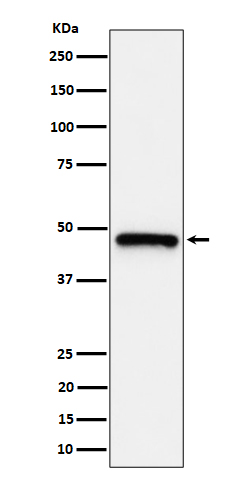
| WB | 咨询技术 | Human,Mouse,Rat |
| IF | 咨询技术 | Human,Mouse,Rat |
| IHC | 咨询技术 | Human,Mouse,Rat |
| ICC | 技术咨询 | Human,Mouse,Rat |
| FCM | 咨询技术 | Human,Mouse,Rat |
| Elisa | 咨询技术 | Human,Mouse,Rat |
| Aliases | Growth inhibitor ING1; Ing1; Inhibitor of growth 1; mING1h; p24ING1c; p33; p33ING1; p33ING1b; p33ING1c; p37Ing1b; p47; p47ING1a; Tumor suppressor ING1;;ING1 |
| WB Predicted band size | 47 kDa |
| Host/Isotype | Rabbit IgG |
| Antibody Type | Primary antibody |
| Storage | Store at 4°C short term. Aliquot and store at -20°C long term. Avoid freeze/thaw cycles. |
| Species Reactivity | Human,Mouse,Rat |
| Immunogen | A synthesized peptide derived from human ING1 |
| Formulation | Purified antibody in PBS with 0.05% sodium azide,0.05% BSA and 50% glycerol. |
+ +
以下是关于ING1抗体的3-4篇参考文献及其简要摘要:
1. **文献名称**: *A candidate tumor suppressor gene at 13q32.3 involved in negative regulation of cell growth*
**作者**: Garkavtsev I., et al.
**摘要**: 该研究首次鉴定了ING1基因作为潜在肿瘤抑制因子,通过抗体检测发现其在多种癌细胞系中表达下调,并证实其过表达可抑制细胞增殖,提示其在肿瘤发生中的调控作用。
2. **文献名称**: *Loss of nuclear expression of the p33ING1b inhibitor of growth protein in breast cancer associates with poor overall survival*
**作者**: Toyama T., et al.
**摘要**: 利用ING1特异性抗体进行免疫组化分析,发现乳腺癌组织中p33ING1b的核表达缺失与患者不良预后显著相关,提示其作为乳腺癌预后标志物的潜力。
3. **文献名称**: *ING1 isoforms differentially regulate cell cycle checkpoints and apoptosis*
**作者**: Coles A.H., et al.
**摘要**: 通过抗体区分ING1不同亚型(如p47和p33),研究发现两者在细胞周期调控和凋亡中具有差异功能,p33ING1b通过p53依赖性途径促进DNA损伤后的细胞周期停滞。
4. **文献名称**: *Epigenetic regulation of ING1 in human melanoma*
**作者**: Helbing C.C., et al.
**摘要**: 研究利用抗体检测黑色素瘤中ING1蛋白表达,结合甲基化分析,揭示ING1表达沉默与启动子高甲基化相关,提示表观遗传失调在其肿瘤抑制功能丧失中的作用。
这些文献覆盖了ING1抗体的应用场景(如表达分析、预后评估、功能研究)及其在肿瘤中的分子机制。
The ING1 (Inhibitor of Growth 1) antibody is a tool used to detect and study the ING1 protein, a member of the ING family of tumor suppressors involved in epigenetic regulation and cellular stress responses. Discovered in 1996. ING1 plays a critical role in chromatin remodeling by interacting with histone acetyltransferase (HAT) or histone deacetylase (HDAC) complexes, thereby regulating gene expression linked to apoptosis, cell cycle arrest, DNA repair, and senescence. It contains a plant homeodomain (PHD) finger that binds histone H3 trimethylated at lysine 4 (H3K4me3), linking chromatin modification to tumor suppression.
ING1 expression is frequently downregulated or dysregulated in cancers, including breast, gastric, and lymphoid malignancies, correlating with poor prognosis. Antibodies targeting ING1 are essential for investigating its expression patterns, subcellular localization (nuclear or cytoplasmic), and interactions in both normal and diseased tissues. These antibodies enable techniques like Western blotting, immunohistochemistry (IHC), and immunofluorescence (IF) to explore ING1’s role in tumor suppression, its splice variants (e.g., p47ING1a, p33ING1b), and its context-dependent pro- or anti-apoptotic functions. Challenges include distinguishing between ING1 isoforms and ensuring specificity due to sequence homology within the ING family. Research using ING1 antibodies continues to clarify its dual roles in cancer and aging, offering potential therapeutic insights.
×